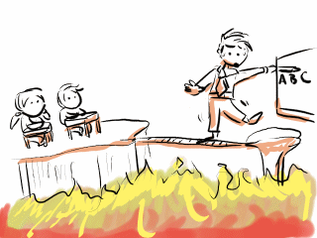TPE 11: Social Environment
|
The Physical Layout
For the student and the teacher, a classroom can alter the mood and motivation for a classroom to learn. While it may not be completely understood, it is known that colors and arrangement of objects in the room can alter the way a person will feel about entering and staying in the room. As a student, this alteration in emotional comfort comes in the form of safety. The student who feels that the room is a safe place will be more likely to learn. This then means that the responsibility to create and set up that environment falls into the lap of the teacher. How the teacher arranges the classroom can either lead to problems created by the environment or as a secondary problem such as student misbehavior because of a poor classroom arrangement. It's easy as Musical Chairs. Seating arrangements can be a pain for teachers, but a skilled teacher will allow the students to tell you who they can or cannot sit next to. For instance on the first week, students were arranged based on their names. This allows for the teacher to observe and get an idea of who will work well with who, and who the general talkers are. The free to sit format also allows for the teacher to see immediately, the personalities of the student and if there is a tendency for them to do something that might present itself as a problem to the teacher. Student's Binding Contract One method to have good classroom management is to have a set of rules created by the students. A student led and created rule set allows for them to know exactly how they should be acting, and to have the student sign the rules would allow them to visually see their binding contract to adhere to the rules and enforcement of the rules. As a teacher, it is important to keep referring to the rules that the students created. This lets the student know that they signed and agreed to the condition set by the class. |
| CA- CCTC: TPE's (Teaching Performance Expectations) |
| Standard : A. Making Subject Matter Comprehensible to Students |
| TPE : TPE
1: Specific Pedagogical Skills for Subject Matter Instruction TPE 1 is divided into two categories intended to take into account the differentiated teaching assignments of multiple subject and single subject teachers. Multiple subject credential holders work in self-contained classrooms and are responsible for instruction in several subject areas; single subject teachers work in departmentalized settings and have more specialized assignments. These categories are Subject-Specific Pedagogical Skills for Multiple Subject Teaching Assignments (1-A), and Subject-Specific Pedagogical Skills for Single Subject Teaching Assignments (1-B). |
| Component : TPE 1A: Subject-Specific Pedagogical Skills for Multiple Subject Teaching Assignments |
|
Standard Area : Teaching
Reading-Language Arts in a Multiple Subject Assignment Candidates for a Multiple Subject Teaching Credential demonstrate the ability to teach the state-adopted academic content standards for students in English-Language Arts (K-8). They understand how to deliver a comprehensive program of systematic instruction in word analysis, fluency, and systematic vocabulary development; reading comprehension; literary response and analysis; writing strategies and applications; written and oral English Language conventions; and listening and speaking strategies and applications. They know how to strategically plan and schedule instruction to ensure that students meet or exceed the standards. Candidates create a classroom environment where students learn to read and write, comprehend and compose, appreciate and analyze, and perform and enjoy the language arts. They understand how to make language (e.g., vocabulary, forms, uses) comprehensible to students and the need for students to master foundational skills as a gateway to using all forms of language as tools for thinking, learning, and communicating. They understand how to use instructional materials that include a range of textual, functional and recreational texts and how to teach high quality literature and expository text. They understand that the advanced skills of comprehending narrative and informational texts and literary response and analysis, and the creation of eloquent prose, all depend on a foundation of solid vocabulary, decoding, and word-recognition skills. Candidates teach students how to use visual structures such as graphic organizers or outlines to comprehend or produce text, how to comprehend or produce narrative, expository, persuasive and descriptive texts, how to comprehend or produce the complexity of writing forms, purposes, and organizational patterns, and how to have a command of written and oral English-language conventions. They know how to determine the skill level of students through the use of meaningful indicators of reading and language arts proficiency prior to instruction, how to determine whether students are making adequate progress on skills and concepts taught directly, and how to determine the effectiveness of instruction and students’ proficiency after instruction. |

